The Pantera got off to a good start with the blessing
(and marketing) of Ford, a deal which, for the few years it lasted, saw
high sales. After the oil crisis and the poor quality of the cars scuppered
the deal with Ford, De Tomaso returned to the realms of low volume manufacturers
where they continued until 1991 with a revised Pantera before introducing a new model, the Guara. Outside investment
saw the Bigua shown in 1996, but the relationship turned sour and the resulting company, Qvale, split off.
Rumours persist about a new Pantera. In
1959 Alejandro De Tomaso established De Tomaso Automobili at Modena, concerned
with the construction of racing cars. Having been born and brought up in
Argentina, he had left (supposedly for political reasons), married an American
lady and moved to Italy. The racing cars used his own chassis and were
powered first by OSCA engines and then Ford units.
In
1959 Alejandro De Tomaso established De Tomaso Automobili at Modena, concerned
with the construction of racing cars. Having been born and brought up in
Argentina, he had left (supposedly for political reasons), married an American
lady and moved to Italy. The racing cars used his own chassis and were
powered first by OSCA engines and then Ford units.
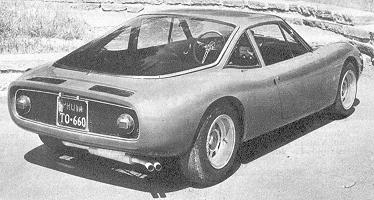 Road cars came later, starting with the mid-engined
Vallelunga (powered by a 1.5-litre Cortina engine) in 1963, then the Mangusta,
and then the classic Pantera. At a similar time the Deauville saloon and
Longchamp 2+2 coupe were developed. All the cars used big Ford V8 engines
and had bodies designed and built by Ghia, a coachbuilder purchased by
De Tomaso (jointly with Ford) in 1967. Vignale was also acquired and used
for production, as was a later relationship with Maggiora.
Road cars came later, starting with the mid-engined
Vallelunga (powered by a 1.5-litre Cortina engine) in 1963, then the Mangusta,
and then the classic Pantera. At a similar time the Deauville saloon and
Longchamp 2+2 coupe were developed. All the cars used big Ford V8 engines
and had bodies designed and built by Ghia, a coachbuilder purchased by
De Tomaso (jointly with Ford) in 1967. Vignale was also acquired and used
for production, as was a later relationship with Maggiora.
Vallelunga
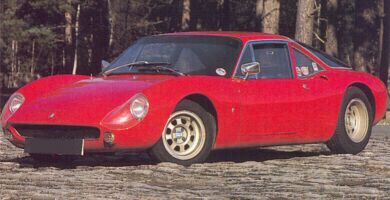 The
first production road car from De Tomaso, the Vallelunga was a mid-engined
(using a Ford 1500cc unit) two seater with a backbone
chassis and a lightweight
fibreglass bodyshell. First shown as a spider at the Turin Motorshow of
1963, this remained a one-off (although competing successfully in various
races), whilst in 1964 at the same show the Vallelunga Coupé was shown.
The
first production road car from De Tomaso, the Vallelunga was a mid-engined
(using a Ford 1500cc unit) two seater with a backbone
chassis and a lightweight
fibreglass bodyshell. First shown as a spider at the Turin Motorshow of
1963, this remained a one-off (although competing successfully in various
races), whilst in 1964 at the same show the Vallelunga Coupé was shown.
The weight saving of the producution cars continued
with perspex windows and an aluminium fuel tank etc. The suspension consisted
on double wishbones at the front and an independent multi-link layout at
the rear. Rose-joints were used throughout. Unassisted disc brakes (assistance
was optional) on all four corners provide the stopping power, more than
adequate for a car which weighed 700kg (47% front/53% rear) in road trim.
A total of 53 coupés were produced from 1965
to 1967 by Ghia, although the original prototype had been built by Fissore.
One variant was built by Fantuzzi, whilst de Tomaso
joined with Ghia to produce the radical 5-litre Sport on the basis of the Vallelunga.
Technical Details
| Engine | 1592cc (82x72.75mm) Ford 4-cyl ohv with 104bhp @ 6,200rpm |
| Suspension | front : Independent with wishbones and coil springs
rear : Independent multilink and coil springs wheelbase : 2310mm track (front/rear) : 1320mm/1350mm |
| Brakes | discs all round |
| Transmission | 4 speed manual (5-speed available as option) |
| Empty weight | 585kg |
click on the name for more details
Deauville
It used the same Ford 5769cc V8 engine as the Pantera,
with 330bhp, only this time mounted in the front of the car. It drove the
rear wheels through a five speed manual ZF gearbox or a three speed automatic
from unit Ford, both with a limited slip differential. Double wishbone and coil suspension was fitted to each
corner as were ventilated disc brakes.
A single example of an estate car was built specially for De Tomaso's wife in which to transport her dogs.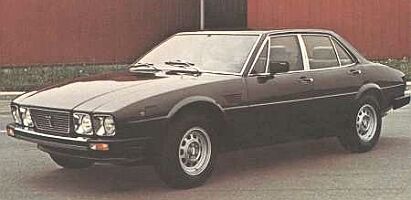 Launched at the Turin Motorshow in 1970, the Deauville was a large, four-door saloon designed by
Tom Tjaarda at Ghia. It entered production in 1971 and continued to be produced
in dribs and drabs until 1988 by which time somewhere between 250 and 350 had been built. Improvements over the
years were few, US legislation bumpers being the most noticeable, whilst minor changes were made internally.
Launched at the Turin Motorshow in 1970, the Deauville was a large, four-door saloon designed by
Tom Tjaarda at Ghia. It entered production in 1971 and continued to be produced
in dribs and drabs until 1988 by which time somewhere between 250 and 350 had been built. Improvements over the
years were few, US legislation bumpers being the most noticeable, whilst minor changes were made internally.
Technical Details
| Engine | 5769cc (101.6x88.9mm) Ford V8 with 330bhp (later 270bhp) |
| Suspension | front : Independent with wishbones and coil springs
rear : Independent with wishbones and coil springs wheelbase : 2770mm track (front/rear) : 1520mm/1520mm |
| Brakes | ventilated discs all round |
| Transmission | 5 speed manual or 3 speed automatic |
| Weight | 1940kg |
Longchamp
Production continued at a very low rate until 1989
by which time 395 coupes and 14 spyders had been built.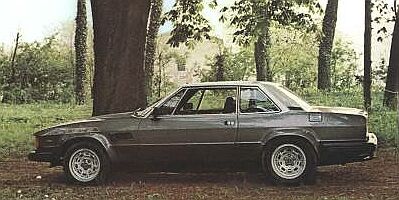 The
Longchamp, introduced in 1972, was effectively a coupe version of the Deauville.
It used a slightly shorter wheelbase chassis with the same suspension,
engine and transmissions. The body design also showed the family resemblance,
despite being a two door coupe. Accomodation was provided for two (plus
two at a push). The bodies were constructed by Ghia and in 1980 a cabiolet version was introduced.
The
Longchamp, introduced in 1972, was effectively a coupe version of the Deauville.
It used a slightly shorter wheelbase chassis with the same suspension,
engine and transmissions. The body design also showed the family resemblance,
despite being a two door coupe. Accomodation was provided for two (plus
two at a push). The bodies were constructed by Ghia and in 1980 a cabiolet version was introduced.
Technical Details
| Engine | 5769cc (101.6x88.9mm) Ford V8 with 330bhp (later 270bhp) |
| Suspension | front : Independent with wishbones and coil springs
rear : Independent with wishbones and coil springs |
| Brakes | discs all round |
| Transmission | 5 speed manual or 3 speed automatic |
Pantera
The Pantera used the same mechanical layout as the
Mangusta, with a mid-mounted 5769cc V8 driving the rear wheels, but the
chassis was much superior, being developed mainly by Dallara. Independent
suspension and disc brakes were employed on all In 1990 a heavily revised version was released. The
mechanicals remained effectively the same (although the engine was now
a 4942cc unit with 305bhp and various changes were made to the brakes etc)
whilst the external styling was facelifted by Marcello Gandini. A 450bhp
twin turbo version was also offered. Only 38 of these final versions were built.
Total production was 7260 cars until it stopped in 1991.
Technical Details (1971 model)
Guarà
Technical Details
De Tomaso
Books : buy them online here (in
association with Amazon)
Links
The Official De Tomaso website.
If you know of any other relevant websites please
send us the details.
De Tomaso comment form
Copyright © 2000 to 2008 CarsfromItaly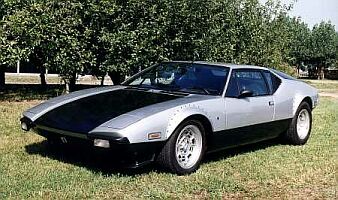 The
Pantera is the classic De Tomaso, probably due to its initial commercial
success deriving from the deal with Ford. The replacement for the Mangusta,
it was introduced at the New York Motorshow in 1970 and was marketed through
Ford's Lincoln/Mercury dealer chain in the USA. This saw 6128 examples
being produced by the end of 1973, a volume which was reduced to the more
normal exotic car dribble in 1974 when Ford withdrew from the deal.
The
Pantera is the classic De Tomaso, probably due to its initial commercial
success deriving from the deal with Ford. The replacement for the Mangusta,
it was introduced at the New York Motorshow in 1970 and was marketed through
Ford's Lincoln/Mercury dealer chain in the USA. This saw 6128 examples
being produced by the end of 1973, a volume which was reduced to the more
normal exotic car dribble in 1974 when Ford withdrew from the deal.
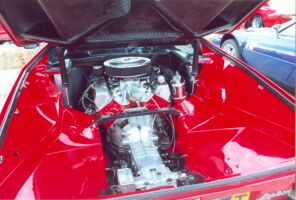 corners,
whilst the body was of unitary construction, designed by Tom Tjaarda of
Ghia. The accomodation was also roomier, and had such luxuries as air conditioning
as standard. During the extended production life of the Pantera various
levels of engine were used, from 266bhp in the most emission strangled US unit to 500bhp in the GT4 version.
corners,
whilst the body was of unitary construction, designed by Tom Tjaarda of
Ghia. The accomodation was also roomier, and had such luxuries as air conditioning
as standard. During the extended production life of the Pantera various
levels of engine were used, from 266bhp in the most emission strangled US unit to 500bhp in the GT4 version.
Engine
5769cc (101.6x88.9mm) Ford V8 with 330bhp
Suspension
front : Independent with wishbones and coil springs
rear : Independent with coil springs
Brakes
discs all round
Transmission
5 speed manual
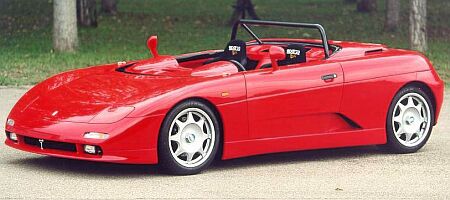 The
Guarà was presented at the Geneva Motorshow
in 1993 as a rear-wheel-drive two seat barchetta with a mid-mounted 4.6-litre
Ford V8. With pushrod suspension, a composite body, stressed engine/transmission
unit and front steel frame it follows GT racecar construction practice.
Designed as a road legal race car, it featured no windscreen and no roof.
The
Guarà was presented at the Geneva Motorshow
in 1993 as a rear-wheel-drive two seat barchetta with a mid-mounted 4.6-litre
Ford V8. With pushrod suspension, a composite body, stressed engine/transmission
unit and front steel frame it follows GT racecar construction practice.
Designed as a road legal race car, it featured no windscreen and no roof.
One year later at the same show a coupe version was introduced.
Engine
4601cc Ford 32 valve V8 with 305bhp @ 6,500rpm
Suspension
front : Independent with wishbones and coil springs
rear : Independent with wishbones and coil springs
wheelbase : 2610mm
Brakes
discs all round
Transmission
6 speed manual
Empty weight
Barchetta : 1050kg
Coupe : 1400kg
De
Tomaso Automobiles
A. Wyss Wallace, 1981
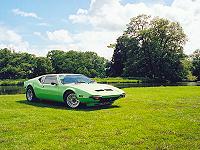
De Tomaso Pantera wallpaper : click on the correct size :
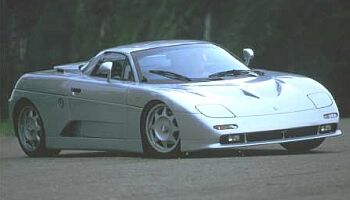 Use
the buttons at the top to navigate further, or
Use
the buttons at the top to navigate further, or
Thanks to De Tomaso Automobili for some of the above pictures.